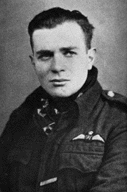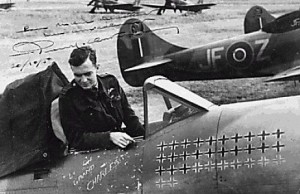Spitfires over France


Pierre Clostermann
Pierre Clostermann was a Free French aviator who flew over 400 missions as a Spitfire and Tempest pilot in RAF squadrons during WWII. He is credited with the destruction (reports vary) of between 15 and 33 Luftwaffe aircraft.
Clostermann was awarded, among numerous other decorations for valor, the Distinguished Flying Cross, the Silver Star and the Croix de Guerre with 19 palms. His memoir, The Big Show (Le Grand Cirque), has sold two and a half million copies. “Take a look at those eyes,” says a friend of mine who was a fighter pilot in the Israeli Air Force. “That’s the look of a combat flier.”

Clostermann in his "Spit"
Incredibly, Clostermann survived the war and went on to run a successful aviation business and serve eight terms in the French National Assembly. His outspoken opposition to the Gulf War of 1991 got him in hot water with many of his old comrades in the Royal Air Force. He was also a sport fisherman of international repute. He died in 2006.
Here is one short passage (I could have picked dozens) from Pierre Clostermann’s The Big Show:
Here and there in the Fortress formations there were gaps. From close to, you could see machines with one, sometimes two stationary engines and feathered propellers. Others had lacerated tail-planes, gaping holes in the fuselages, wings tarnished by fire or glistening with black oil oozing from gutted engines.
Clostermann’s Spitfire was serving as a fighter escort for these American and British bombers, struggling to make it back to base after raids over occupied France.
Behind the formation were the stragglers, making for the coast, for the haven of refuge of an advanced air base on the other side of the Channel, flying only by a sublime effort of the will. You could imagine the blood pouring over the heaps of empty cartridges, the pilot nursing his remaining engines and anxiously eyeing the long white trail of petrol escaping from his riddled tanks. These isolated Fortresses were the Focke-Wulf’s [fast German fighters] favourite prey. Therefore the squadrons detached two or three pairs of Spitfires, charged with bringing each one back safe: an exhausting task as these damaged Fortresses often dragged along on a third of their total power, stretching the endurance of their escort to the limit.
On this occasion Ken sent Carpenter and me to escort a Liberator which was only in the air by a miracle. Its No. 3 engine had completely come out of its housing and hung on the leading edge, a mass of lifeless ironmongery. His No. 1 engine was on fire, the flames slowly eating into the wing and the smoke escaping through the aluminum plates of the upper surface, buckled by the heat. Through the tears in the fuselage the survivors were throwing overboard all their superfluous equipment—machine guns, ammunition belts, radio, armour plates—to lighten the machine, which was slowly losing height.
To crown all, there was a burst in the hydraulic system, freeing one of the wheels of the undercart, which hung down and increased the drag still further.
Clostermann’s “Spit” was powered by a 12-cyllinder supercharged Rolls-Royce Merlin engine that delivered 1600 horsepower.
At 1,800 revs., minus 2 boost and 200 m.p.h. we had to zigzag to keep level with him … still over France, 12 miles behind the main formation. Ten Focke-Wulfs began to prowl round us, at a respectful distance, as if suspecting a trap. Anxiously Carp and I kept an eye on them.
Suddenly they attacked, in pairs. Short of juice as we were, all we could do was face each attack by a very tight 180-degree turn, fire a short burst in the approximate direction of the Hun, and immediately resume our position by another quick 180-degree turn. This performance was repeated a dozen times but we succeeded in making the Focke-Wulfs keep their distance …
Over Dieppe the fighters gave way to the flak. We were flying at about 10,000 feet. The German light flak opened fire with unbelievable ferocity. An absolute pyramid of black puffs charged with lightning appeared in a fraction of a second. Violently shaken by several well-aimed shells, Carp and I separated and gained height as fast as we could with our meagre reserves of petrol. The poor Liberator, incapable of taking any sort of violent evasive action, was quickly bracketed. Just as, after a few agonizing seconds, we thought it was out of range there was an explosion and the big bomber, cut in half, suddenly disappeared in a sheet of flame. Only three parachutes opened out. The blazing aluminum coffin crashed a few hundred yards from the cliffs in a shower of spray, dragging down the remaining members of the crew.
With heavy hearts we landed at Lympne, our tanks empty.
Luckily we were often more fortunate than this and succeeded in bringing our charges back to our airfield at Detling, where our arrival always caused the greatest agitation—ambulances, fire service, curious onlookers. We felt fully repaid by the gratitude in the eyes of the poor exhausted fellows. In many cases it was only the moral support of the presence of a pair of Spits that gave them the courage to hold out to the end, to resist the temptation of baling out and waiting for the end of the war in some Oflag [prison camp] or other.




Guys like that saved us all. I probably wouldn’t have been born at all, had it not been for the courage of men like these.
True. And don’t forget the courage of a countless change of your women ancestors who had the courage to give birth. Your life is also dependent on each and every one of them. Is that the level of physical courage you have? Would be willing to undergo such pain and risk of death to bring someone into the world? Just one more thing for us all to be grateful for. No disrespect intended towards anyone.
I read “The Big Show” almost 40 years ago. Still on my shelf in front of me along side “They Shall Not Pass Unseen” by Ivan Southall. Two of the finest books of flying and war.
Hi Steven: Enjoyed your article, love Le Grand Cirque, one of the all-time great war memoirs. But I thought you should know: the cockpit photo does not show P.C. not in a Spit, but in his 274 Squadron Hawker Tempest Mk.V NV724, “Le Grande Charles.”(Probably immediately post-war as there is some doubt he marked his Tempests with the scoreboard shown here during the war.) See this photo and more info at http://www.hawkertempest.se/clostermann.htm
Best, Patrick
What a story! It has the ring of truth, and, surely, one can become subjective – but he had cameras. I survived a few sea-tempests, all alone in a canvas canoe, attempting to reach safe harbour. I well remember the nor-adrenaline spikes that left me, feeling as ‘godlike Odysseus’, throwing my tiny craft into the raging surf, now lost in the inky depths of a trough, now launching myself at an angle over the huge wave-crests. Small by comparison, but the danger and with it the thrill and excitement were real: so immanently real I can still, after many years, recount each minute of my adventures, crossing the reef-like rocks, as my companion cried for ‘help’ I was unable to give. Then the Pilot boat, filled with police, which rescued him. Two weeks later, the same boat, tossed along the side of a Swedish tanker, was shredded by the propellers. How must Mr Clostermann have been able to recount every second of each and every encounter with death. How I wish I’d been there! How proud I am to have read his encounters, and how trivial it is to debate how many ‘kills’. What a hero!